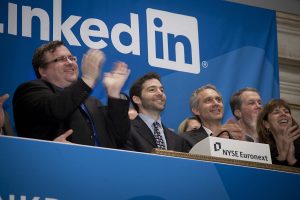 Last year Fortune Magazine ran a cover page article on LinkedIn. The article discussed the amazing qualities and attributes of this “Darling of Wall Street” company. It was a total love fest.
Last year Fortune Magazine ran a cover page article on LinkedIn. The article discussed the amazing qualities and attributes of this “Darling of Wall Street” company. It was a total love fest.
I was reading the article while en route to Haiti, and I decidedly put the magazine aside and looked out the plane window with my son Noah, enjoying the deep blue Caribbean waters. To Noah, I was putting away business and starting to relax. To me, I was opting out of reading an incredibly irritating article.
I didn’t pick up the magazine again until we returned home. When I tried again and then yet again to read the article on LinkedIn, I had the same irritated reaction.
In the article, Paul Maxim, head of global recruiting for Unilever, says, “We didn’t have to pay a headhunter.” The article also states that 88 of the Fortune 100 have licensed software to help find and track potential job candidates.
So, I ask these companies, how many people do your companies lose because of LinkedIn? Seriously, LinkedIn is currently responsible for some of the highest turnover ever in the history of the modern world.
I Would Ban LinkedIn
Let’s stop pretending, as this love fest of an article does, that LinkedIn is the Facebook for professionals. If I were the CEO of a large company – and I predict this will eventually happen – I would direct my employees to have company approved LinkedIn pages, or just out and out ban it.
I saw a profile the other day, and you would have thought that this guy flies around the world at the speed of light and has a f******! cape on his back. Really? You single-handedly returned the company to profitability? Why don’t we ask your director, the Executive VP, or the CEO if he or she agrees?
The Overfishing Problem
Now, let’s get to headhunting. Yes, I have three licenses for LinkedIn. And yes, I have made my money back ten-fold from this site, but on the other hand, how much have I lost?
It is no secret that the engineering job market is tight, but something weird is happening. It was normal for young, up and coming engineers to have a couple of job offers. Now I routinely see candidates who have four or five offers or however many they need to satisfy their egos.
Also, why don’t you ask these candidates how many InMails and requests they get from recruiters? The sheer volume of requests can be mind-boggling for these candidates who are in their mid-20s to early 30s. In fact it is very common for me to see the message: InMail declined. The request was appropriate, but not at that time. I actually had an engineer decline me and then say that it was not appropriate. Huh?? Seriously?? Why the hell are you on here then?
Profiting From Turnover
This leads me to the real point. The vast majority of people on LinkedIn do not even understand how LinkedIn gets its profits. They don’t understand that LinkedIn is really a site developed, not to build companies up, but to tear them down. For LinkedIn, turnover means profits.
People are shocked when I tell them that I pay a lot of money for LinkedIn licenses. Do you think the people who work at this behemoth of a company really care about the “groups” and all of the other frivolous areas on the site? It is truly a new game.
Our profession is changing in large part due to this website. Candidate ownership is eroding away faster than you can believe, and recruiting is becoming less about relationships and more about gathering information. Yes, our company also has a research division in Mexico, and what do our researchers spend part of their day doing? You guessed it — building LinkedIn lists for our recruiters and our research customers.
Riding the LinkedIn Wave
Yes, LinkedIn is a wave, and it’s a big one. Despite my irritation with LinkedIn, it certainly deserves credit for creating this wave and weakening the importance of other career websites such as Monster and CareerBuilder. Along with many others, I am riding this wave until the next best thing arrives, and then we will ride that wave as well.
I often say recruiting is “a dog chasing his tail.” I just never knew that tail would spell LinkedIn.